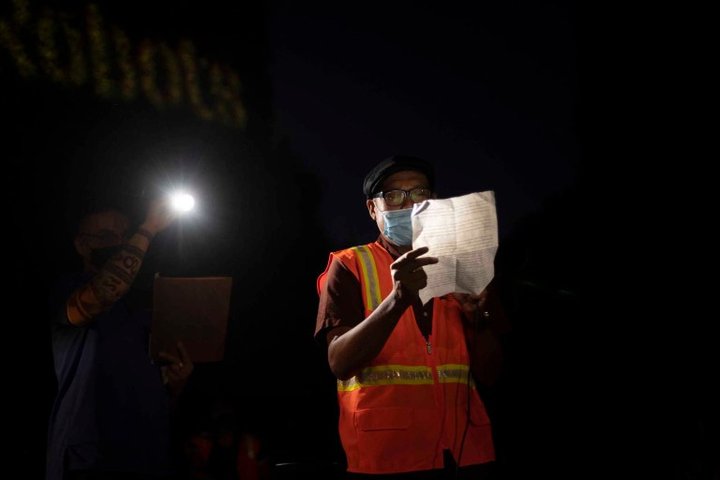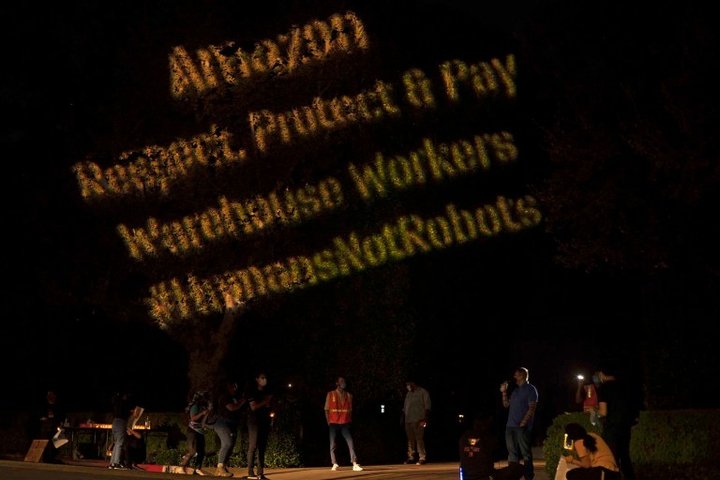
A protestor holds a candle during a mock vigil in front of Amazon CEO Jeff Bezos’ house in Beverly Hills on Prime Day, Oct. 13, 2020. Photo by Tash Kimmell for CalMatters.
###
“Jeff Bezos is the real virus,” yells Enrico Maniago.
The warehouse worker organizer decried the world’s richest man for profiting off laborers and contributing to income inequality as a small crowd lined up along Angelo Drive in Beverly Hills. Behind him, the green expanse of a massive hedge and a pitch-black steel gate towered over, hiding Amazon CEO Jeff Bezos’ $165 million mansion from sight.
At a mock vigil Tuesday night, protesters brought plastic candles, which provided soft lighting on an otherwise dark street, to highlight the plight of Amazon’s frontline workers on Prime Day, the e-commerce giant’s annual flagship sales event. At one point, the crowd broke out in chant: “Hey Jeff Bezos, you can’t hide. We can see your greedy side.”
The demonstration was organized by the Warehouse Worker Resource Center, a Southern California nonprofit worker advocacy group trying to raise awareness about unsafe working conditions inside Amazon warehouses as the company continues to expand. It’s the second time this month advocates targeted Bezos’ home.
Amazon is also catching the attention of California’s worker protection agency. Last week the California Occupational Safety and Health Agency, or Cal/OSHA, cited Amazon for coronavirus safety violations at its Hawthorne delivery center and Eastvale fulfillment center. The fines — $935 at each facility — represent the smallest penalties that Cal/OSHA has imposed on employers for COVID-19 related violations.

Enrico Maniago, an organizer with the Warehouse Workers Resource Center, condemns Amazon’s handling of the COVID-19 pandemic during a Prime Day protest on Oct. 13, 2020. Photo by Tash Kimmell for CalMatters.
Despite phasing out pandemic incentives, Amazon says it’s done plenty for its workers. Over the summer, Amazon paid full-time employees who worked during the month of June a one-time $500 bonus. The company said it paid over $500 million in bonuses that month.
“It was obvious to the full-time workforce that this organization used Prime Day to raise its own visibility, conjured misinformation and a few associate voices to work in their favor, and fuel media attention,” the company wrote in a statement to CalMatters.
Amazon points out the company has invested $4 billion in COVID-related initiatives to provide safe working conditions, but workers say there’s been a lack of transparency and communication about infections.
“This has been one of the main frustrations of workers,” said Tim Shadix, legal director of the Warehouse Worker Resource Center. “Amazon won’t even tell them how many cases there have been at their workplace.”
In late March, a Cal/OSHA agent wrote in a summary after receiving a complaint about the Eastvale fulfillment center how workers were scared after two employees tested positive “but the rest of warehouse employees are required to work with no restrictions, no Personal Protective Equipment.”
At the Hawthorne facility, an agent wrote: “NO SOCIAL DISTANCING.”
Even so, Cal/OSHA has closed many worker complaints related to COVID hazards without any inspection or citation. As of Oct. 4, the agency closed at least 29 complaints related to Amazon facilities across the state, according to federal complaint data. The records show that only one resulted in an on-site inspection. Cal/OSHA likely dealt with the rest by sending a letter, which CalMatters has reported is the agency’s default strategy for dealing with coronavirus related complaints.
The closed complaints from around the state range from allegations that Amazon trucks were not sanitized, drivers were not socially distanced during morning meetings, work areas weren’t cleaned after workers were diagnosed with the virus, sick employees were showing up to work without protective equipment, social distancing was not possible within fulfillment centers, and managers weren’t enforcing mask wearing or even wearing their own masks properly.
Earlier this month, Amazon revealed that 20,000 of its 1.37 million Amazon and Whole Foods workers in the United States had tested positive for the coronavirus from March 1 to Sept. 19.
The report did not offer a detailed breakdown of the case data, but Amazon noted that its infection rate was lower than that of the general U.S. population.

Protestors project the words “Amazon respect, protect and pay warehouse workers #humansnotrobots” onto shrubs outside Amazon CEO Jeff Bezos’ house during a Prime Day protest on Oct. 13, 2020. Photo by Tash Kimmell for CalMatters
Amazon bumped hourly pay from $15 to $17 in March and workers were allowed to take unlimited unpaid time off. By June, Amazon scrapped both policies.
Outside the Bezos home, demonstrators called on the CEO to bring those benefits back.
One of the demonstrators who refused to give his name for fear of employer retribution said as an Amazon delivery driver, he is preparing to work 12-hour shifts without breaks as Prime Day kicks off the cyber holiday shopping season.
“I’m not going to have time to take my 10-minute breaks. Some drivers have to skip their 30-minute lunch breaks. I’ve had to do that as well,” he said. “It’s either do that and keep making them money, or your job is at risk.”
Bezos’ Beverly Hills home was visited last week by another worker’s rights group organized by Chris Smalls, a former Amazon warehouse supervisor who made headlines in April when he was fired by the company after organizing a walkout in Staten Island.
Smalls has since formed the Congress of Essential Workers, which organized in front of Bezos’ New York residence on Prime Day, when workers have to put in longer hours of labor-intensive work.
“When I had new hires come in, as a supervisor, I would tell them if they had a gym membership they might want to cancel it,” Smalls said.
###
CalMatters reporter Jackie Botts contributed to this report. This article is part of the California Divide, a collaboration among newsrooms examining income inequity and economic survival in California.
CALmatters.org is a nonprofit, nonpartisan media venture explaining California policies and politics.
CLICK TO MANAGE